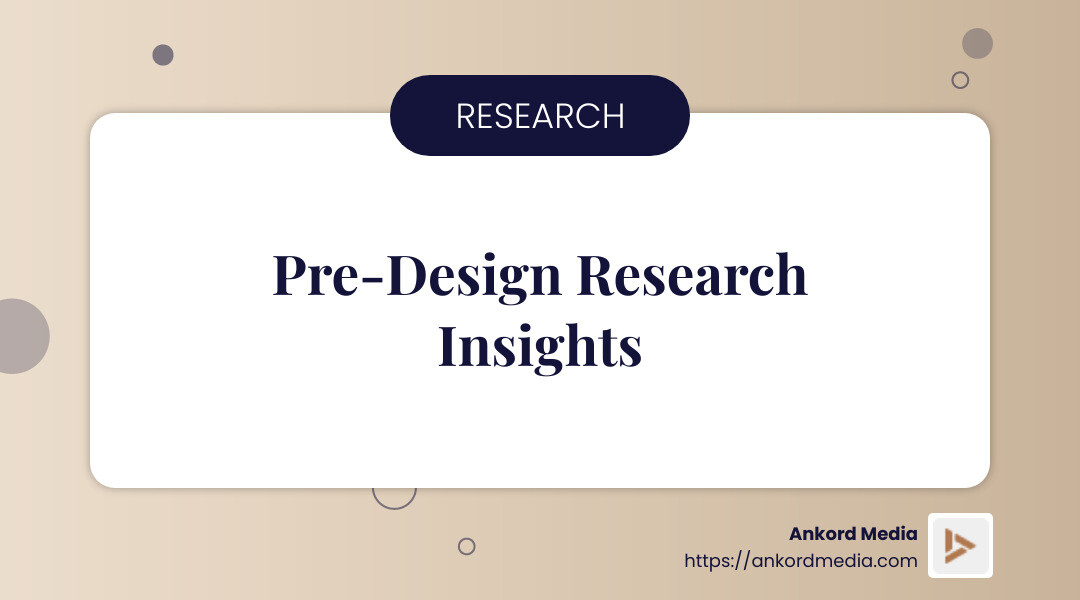
Digital experience design is about crafting every aspect of a user's digital interaction to be seamless, engaging, and purposeful. In today’s digital world, creating meaningful online interactions requires a holistic approach that goes beyond aesthetics. Key elements include:
- User-Centric Design: Focus on understanding user needs and behaviors.
- Emotional Engagement: Create interactions that resonate emotionally.
- Seamless Experiences: Ensure consistent user journeys across platforms.
This comprehensive approach isn't just about making things look good—it's about making sure each digital interaction aligns with user expectations and business goals.
I'm Milan Kordestani, and at Ankord Media, I specialize in helping businesses define their brand identities through coherent digital experience design. From years of experience right from the heart of Silicon Valley, I’m passionate about changing bold visions into compelling digital realities.

Understanding Digital Experience Design
Digital experience design is all about how users interact with digital products and services. It includes three main elements: user interface (UI), user experience design (UXD), and customer experience (CX). Each plays a vital role in shaping how users perceive and engage with your brand.
User Interface (UI)
Think of the user interface as the gateway to your digital world. It's the visual part of a product that users interact with. A well-designed UI is clean, attractive, and easy to understand. It’s like walking into a room that feels just right—everything is in its place, and it makes sense.
Key Performance Indicators (KPIs): Cleanliness, attractiveness, and understandability.
User Experience Design (UXD)
User experience design focuses on the quality of interaction users have with your product. It’s about making sure users can achieve their goals efficiently and enjoyably. UXD is like the flow of a conversation—smooth, logical, and engaging.
Key Performance Indicators (KPIs): Promptness and effectiveness of the system to perform the intended task.
Customer Experience (CX)
Customer experience takes a broader view, looking at the entire journey a user has with your brand. It covers everything from the first interaction to ongoing support and updates. CX is akin to a long-term relationship, where every touchpoint builds trust and loyalty.
Key Performance Indicators (KPIs): Loyal customers, long-term relationships, and word-of-mouth marketing.

Understanding these components is crucial for creating a digital experience design that not only meets user expectations but also drives business success. By focusing on UI, UXD, and CX, businesses can ensure that their digital products are not only functional but also delightful to use.
Next, we’ll explore the key components of digital experience design, diving deeper into user research, information architecture, and emotional design.
Key Components of Digital Experience Design
To create exceptional digital experience design, we need to dive into three essential components: user research, information architecture, and emotional design. Each plays a unique role in crafting digital interactions that are both effective and delightful.
User Research
User research is the backbone of any successful digital design project. It involves understanding what users need and how they behave. This can be achieved through interviews, surveys, and analyzing existing user data.
By creating detailed user personas, designers can empathize with their audience. These personas act as guides, helping to tailor the digital experience to specific groups. Imagine designing a new app: knowing your users' habits and preferences can help make it intuitive and engaging from the start.
Information Architecture
Information architecture is about organizing and structuring content in a way that's easy to steer. Think of it like a library—well-organized shelves make finding books simple and enjoyable.
In digital design, this means creating a clear hierarchy and logical flow for users. When users can find what they need quickly, they’re more likely to enjoy their experience and return. This component is crucial for ensuring that the interface is intuitive and user-friendly.
Emotional Design
Emotional design focuses on creating connections that resonate on a deeper level. It's not just about how something looks, but how it makes users feel. A well-crafted digital experience can invoke emotions that foster loyalty and keep users coming back.
Consider a beautifully designed app that uses warm colors and friendly language. It doesn't just function well; it makes users feel welcome and valued. Emotional design is about building these positive feelings into every interaction.

Incorporating these components into your digital experience design ensures that your digital products are not only functional but also enjoyable and meaningful. Next, we’ll explore how human-centered design improves these components by focusing on empathy and user behavior.
The Role of Human-Centered Design
Human-centered design is all about putting people first. It's a design approach that focuses on understanding users' needs, behaviors, and mindsets. This approach ensures that digital products are not only useful but also meaningful and engaging.
Empathy: Walking in Users' Shoes
Empathy is at the heart of human-centered design. It's about understanding what users feel and need. By stepping into their shoes, designers can create experiences that truly resonate.
Imagine designing a new feature for an app. Empathy helps designers anticipate what users might struggle with and what they might enjoy. It guides decisions that make the experience smoother and more intuitive.
User Behavior: Observing and Understanding
To design effectively, it's crucial to observe how users interact with digital products. This involves looking at patterns in user behavior and understanding what drives their actions.
For instance, if users frequently abandon a shopping cart, there might be a barrier in the checkout process. Observing this behavior allows designers to identify and remove obstacles, creating a more seamless experience.
Mindset: Designing with Purpose
Mindset in design is about having a clear purpose and direction. It's understanding what users want to achieve and helping them get there efficiently.
Consider a website aimed at helping users learn a new skill. The design should guide users through their learning journey, providing resources and support along the way. This purposeful design aligns with users' goals, making the experience more satisfying.
By focusing on empathy, user behavior, and mindset, human-centered design creates digital experiences that are not just functional but also deeply engaging. Next, we'll dive into the digital experience design process, exploring how research, prototyping, and collaboration bring these concepts to life.
Digital Experience Design Process
Creating a digital experience design that truly connects with users involves several key steps. Let's break down the process into three main components: user-centered research, iterative prototyping, and cross-functional collaboration.
User-Centered Research
User-centered research is all about understanding who your users are and what they need. This research forms the backbone of any successful design project.
- Observation and Interviews: Start by observing users in their natural environment or conducting interviews. This helps gather insights into their behaviors, preferences, and pain points.
- Surveys and Feedback: Use surveys to collect quantitative data. Feedback loops are crucial for refining ideas based on real user input.
- Personas and User Stories: Create personas and user stories to visualize and empathize with your users. This helps in designing experiences that are custom to their specific needs.
By putting users at the center of the research process, you ensure that the final design is not only functional but also resonates with the audience.
Iterative Prototyping
Prototyping is where ideas start to come to life. But it’s not a one-and-done deal—iteration is key.
- Low-Fidelity Prototypes: Begin with simple sketches or wireframes. These low-fidelity prototypes allow you to test ideas quickly and gather early feedback without too much investment.
- User Testing: Conduct user testing sessions with these prototypes. This helps identify what works and what doesn’t, leading to informed design decisions.
- Refinement: Based on feedback, refine and improve your prototypes. This cycle of testing and refining continues until the design meets user needs effectively.
Iterative prototyping ensures that the design evolves based on real user interactions, leading to a more polished and user-friendly final product.
Cross-Functional Collaboration
Creating a digital experience is not a solo endeavor. It requires collaboration across different teams and expertise.
- Designers, Developers, and Marketers: Bring together designers who focus on the look and feel, developers who understand the technical feasibility, and marketers who know the audience and brand voice.
- Regular Check-Ins: Schedule regular meetings to align goals and share progress. This keeps everyone on the same page and helps resolve issues promptly.
- Shared Goals: Ensure that all team members understand the project’s objectives and user needs. A shared vision helps in creating a cohesive and effective digital experience.
Cross-functional collaboration leverages diverse skills and perspectives, leading to a more comprehensive and successful design outcome.
By integrating user-centered research, iterative prototyping, and cross-functional collaboration, the digital experience design process becomes a powerful tool for creating meaningful and engaging digital products. Next, we'll tackle some frequently asked questions about digital experience design, explaining this essential practice.
Frequently Asked Questions about Digital Experience Design
What is digital experience design?
Digital experience design is all about crafting meaningful interactions in the digital world. It's the art and science of making sure every touchpoint—whether a website, a mobile app, or any other digital platform—delivers a seamless and engaging experience for users. Imagine it as creating a digital journey where each step feels intuitive and satisfying.
This design process goes beyond just making things look good. It focuses on how users interact with digital products and ensures that these interactions are smooth and purposeful. By understanding user needs and behaviors, designers create experiences that align with both user expectations and business goals.
How does digital experience design differ from UX design?
While both digital experience design and UX design aim to improve user interactions, they differ in scope. UX design traditionally focuses on the usability and functionality of a product, ensuring that it is easy to use and meets user needs. It's like fine-tuning the engine of a car to ensure a smooth ride.
Digital experience design, on the other hand, takes a broader view. It encompasses not only the usability but also the entire digital journey across various platforms and touchpoints, such as websites and mobile apps. It's about creating a cohesive experience that feels consistent and engaging, no matter how or where users interact with the brand.
What are examples of digital experience design?
One standout example of excellent digital experience design is Netflix. Known for its seamless interactions, Netflix provides a user-friendly interface that makes finding and watching content a breeze. Its design ensures that users can easily steer across devices, from smartphones to smart TVs, without missing a beat.
The magic of Netflix lies in its ability to deliver a consistent and enjoyable experience, no matter the platform. This is the essence of digital experience design—creating an environment where users feel connected and engaged at every digital touchpoint.
By focusing on user interaction and the digital journey, companies can create experiences that not only meet but exceed user expectations. In the next section, we'll explore how Ankord Media leverages strategic branding to craft authentic connections in the digital world.
Conclusion
At Ankord Media, we believe that digital experience design is more than just a buzzword. It's a commitment to creating authentic connections between brands and their audiences. Our approach is rooted in strategic branding and cutting-edge design, allowing us to transform bold ideas into tangible success.
Strategic Branding with Visionary Clients
Our work begins with understanding the unique vision of our clients. By partnering with visionary leaders who are unafraid to challenge the status quo, we craft digital experiences that resonate deeply with their audience. This collaboration ensures that every project is not just about aesthetics but about telling a compelling story that aligns with the brand's core values.
Creating Authentic Connections
In today's digital landscape, authenticity is key. Users crave genuine interactions, and we deliver by focusing on human-centered design principles. We leverage user research to understand behaviors and preferences, ensuring that every touchpoint is intuitive and engaging. This approach helps us build digital journeys that foster trust and loyalty.
Our projects are more than just digital products; they are experiences that leave a lasting impression. Whether it's a seamless website or an immersive mobile app, we ensure that each interaction feels personal and meaningful.
Changing Ideas into Success
At Ankord Media, our success is measured by the impact we create for our clients. We take pride in our ability to amplify their visionary ideas, turning them into reality through strategic branding and innovative design. Our commitment to excellence ensures that every project not only meets but exceeds expectations.
In the changing digital world, staying ahead requires adaptability and creativity. We are dedicated to crafting digital experiences that not only captivate but also inspire. Join us on this journey to create impactful connections that drive business growth and redefine the future.
For more insights into how we can transform your brand's digital presence, visit our website. Let's craft connections that make a difference.


